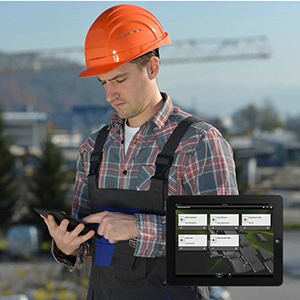There is no doubt that the government’s decision to demand suppliers involved in public sector projects use BIM tools and techniques by 2016 has focused the attention of the construction industry.
To date, this approach has only facilitated collaboration in the early phases of building design and construction. And while there is no doubt that early insight into potential problems is key to minimising delay and costs, it could be argued that BIM’s improved information resource has significantly more potential on site.
Today, far too much time is lost on site as a result of workers lacking the required information to do the job. While the problem is manageable if the site office is only minutes away, on major construction projects for roads or other infrastructure, this is rarely the case and operatives have to travel miles to attain information or carry vast quantities of paper-based information – with no guarantee it’s up to date.
Given the general pressure on pricing, construction companies and clients simply cannot afford to waste time due to lack of information. Nor can they risk mistakes due to inaccurate, incomplete, out-of-date, or just incorrect information that leads to rework, getting rid of the old materials and the carbon overhead.
With a consolidated information resource that includes drawings, specifications, commissioning requirements, method statements, health and safety assessments, environmental assessments, and supply chain logistical information, a company can extend BIM from the original design through on-site construction to on-site maintenance and repair.
Add in key resources such as time sheets and employee training records to ensure they have the right skills and equipment expertise, and the technology also improves site management and project control.
The essence of BIM is information sharing, not only 3D designs but also the related documents. These could include anything from the part reference numbers or documentation, through the maintenance scheduling, to the social media conversation where decisions were made about how best to construct it.
Providing a worker with access to the information they require at the point of activity, relevant to their role and the task they are performing, could dramatically improve their productivity and efficiency. But it is important not to overwhelm an individual with too much information or information that isn’t relevant to their role.
In addition, location-based services and technologies can be used to identify the worker, their location on site, and work package being performed, making it possible to provide them with relevant information, and the ability to access more in-depth information as needed. This information needs to be available for both online and offline use to help ensure workflows continue seamlessly. Such personalised views into information relevant to the individual user’s project and role cut down wasted time trying to find documents.

Given the general pressure on pricing, construction companies and clients simply cannot afford to waste time due to lack of information. Nor can they risk mistakes due to inaccurate, incomplete, out-of-date, or just incorrect information.– Iain Miskimmin
But there are some obvious challenges associated with delivering mobile technology on a construction site – from the availability of connectivity to the durability of devices and health and safety concerns.
Many construction companies have banned the use of mobiles on site, because of the risks associated with distraction, putting them in danger from powered equipment and site-based hazards. One possible solution is adopting Real Time Location Services (RTLS) technology that leverages wi-fi and other systems to alert the individual to the nearby presence of vehicles or equipment.
A new approach to the procurement of mobile IT hardware could also reap significant cost savings. Traditionally, companies have invested “ruggedised” equipment that requires careful selection and testing and is often very costly to purchase and maintain. This approach requires that assets have a long period of four or five years in use to derive the maximum value from the investment. During this time the equipment can become effectively obsolete, given the rapid pace at which mobile IT is evolving.
But consumer-targeted hardware (such as tablets) give the opportunity for a new perspective. Tablets are cheap to buy and can be retrofitted with durable cases. The significantly lower costs mean that these devices can be regarded much like a consumable item and replaced more cheaply once damaged beyond economic repair.
Couple this with the fact that many companies now give their users these new devices after a period of company use means that users value and look after their equipment more. Some companies have seen replacement levels actually fall from figures of around 20-30% a year to around 3% – a significant saving.
The challenges and opportunities offered by the government’s commitment to its BIM strategy are going to drive significant changes in the way our industry works and collaborates with information on construction projects.
But the 20% cost savings identified will not be realised simply during the planning and design phases of the project lifecycle – the big benefits will be achieved on site during construction and through more effective operations and maintenance, which will demand real-time, mobile access to in-depth and tailored asset information.
Iain Miskimmin is a consultant at Bentley Systems and director of technology at Construction Opportunities for Mobile IT (COMIT)












